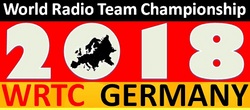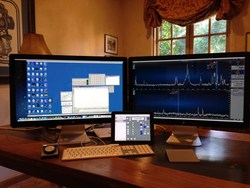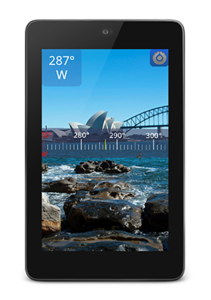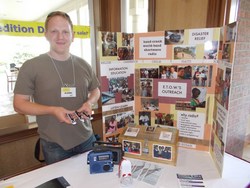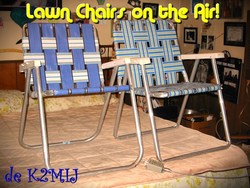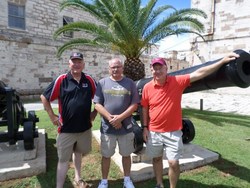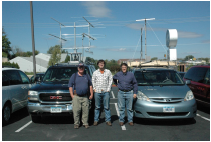 October 8, 2014 Editor: Ward Silver, NØAX | ||||||||
IN THIS ISSUE
NEW HF OPERATORS - THINGS TO DO Ten meters has been hot lately - why not give the 10-10 CW Contest a try and see what you can work on the upper end of our HF spectrum? Then turn down the power and jump into the QRP ARCI Fall QSO Party - the biggest QRP contest of the year. You might be pleasantly surprised at what you can put in the log with only five watts! BULLETINS The dates for the EU Sprints are incorrect on the EU Sprint website: SSB was last weekend on the 4th and CW is this coming weekend on the 11th. This reflects the first- and BUSTED QSOS No bad content was reported in the previous issue. CONTEST SUMMARY Complete information for all contests follows the Conversation section Oct 11-12
Oct 18-19
Big news has been received from Germany - a committee has been formed to sponsor the 2018 edition of the World Radiosport Team Championships and their application enthusiastically accepted by the WRTC Sanctioning Committee! The WRTC2018 committee (web URL announced 9 October - www.wrtc2018.de/en - Thanks, Daily DX) consists of well-known and experienced contesters from the Deutscher Amateur Radio Club (DARC), Bavarian Contest Club (BCC), and Rhein-Ruhr DX Association (RRDXA). The general approach will be similar to prior WRTCs although the qualification process - which will be announced soon - is likely to be shorter than for WRTC2014. Watch for more bulletins as the sponsors hit the ground running! Sherwood Engineering has released a new table of receiver ratings - and a new "king of the narrow-spacing dynamic range hill" as the FlexRadio 6700 appears atop the list at 108 dB. In what is an indication of the brave new world of SDR behavior, the 6700 exhibits the unique behavior of having a higher close-spacing dynamic range than wide-spaced. Note Y below the table explains that the behavior is characteristic of SDR equipment that digitizes the RF signal close to the antenna. As long as there is sufficient data resolution - it's all bits. Wolfgang DK9VZ reports that there is a new set of General Rules for all DARC Contests. This applies to all DARC HF and DX contests. Qatar should be in a lot of CQ WW SSB logs this year. A71BX will be active once again as a Multi-Multi entry and A73A will be participating with a multi-national team in the Multi-Two category from a site near the beach. These groups of friends intend to have a lot of fun and work a lot of stations - this should be easy if conditions stay good, particularly on the high bands. It's great to see the A7 prefix so active! (Thanks, Dave K5GN)
Stu K6TU announces, "I am planning to release a new version of the Super Check Partial database files on October 14th. I am requesting your logs for input to the database files. Please send your logs for this release before October 13th." That is next Monday! Email Stu your Cabrillo format logs created in the past 24 months. No ZIP, ADIF, or compressed files, please. Send them as separate attachments. You may send files any time, of course, but if you want to contribute to the next release, send them now. You've seen the 2D "QR codes" and maybe even used them for an airline boarding pass. A recent Instructable project gave Frank KR1ZAN an idea for labeling your equipment with your name and call. "The QR code could be placed inside an HT's case under the battery, on the bottom of a rig, or next to the serial number plate or inside the lid...the QR code could link to a web site or a phone number, but, should say something like "Property of Kxnyyy". Most thieves won't know what this is and hams could get in the habit of using a smartphone to scan and read the QR code of used equipment before making a purchase." Ham-Com, the largest amateur radio convention in Texas, announced that it would be moving the location of the 2015 convention from the Plano Center to the Irving Convention Center. The Ham-Com board of directors deemed the move necessary due to the increased growth they have experienced over the past several years. (Thanks, Tim K3LR)
Peter WW2Y discovered a free app for the Android OS called Survey Compass (at right). The app uses a smartphone camera for sighting and displays heading plus other info directly on the image in Ruler Mode. It also has a map-style Grid Mode and a standard compass-style view. You can store images into your default photo folder. A new Space Weather Prediction Center website will be operational next Tuesday, October 14. Following that date the www.spaceweather.gov and www.swpc.noaa.gov sites will link to the new web site which is in late beta-testing. The familiar Spaceweather website will remain active as a legacy site for another 60 days as a transition. (Thanks, Daily DX) At the Final Plenary of the 23rd IARU Region I General Conference the following members were elected to serve on the Executive Committee. Contesters will recognize some familiar calls!
You know how it is that some remote place just seems to call out for years before you can finally visit? For Chris ZS6EZ that place was Labrador (VO2). Read about how he finally made it to his Shangri-La and visited WRTC2014 along the way in his super travelogue about the experience. Who came first and what preceded what in the tumultuous field of telecommunications? This historical timeline may help answer a few questions and settle a wager or two. (Thanks, Tim K3LR) Web Site of the Week - In ways very similar to Amateur Radio's ability to observe and report, this recent NY Times story on atmospheric sprites presents a great example of "citizen science." Why not start bouncing some signals off of sprites and jets to see what radio properties they have? Game on! WORD TO THE WISE Dick WC1M contributed this recent discussion of using high-performance climbing gear to do tower work. Lightweight and flexible, this safety equipment may be just what you're looking for! EDN blogger, Ken Wyatt (who I believe is KX7KW), recently made a visit to the ARRL and spent some time with ARRL Lab staff. The title of his web page is The EMC Blog, so it was natural for him and ARRL EMC engineer, Mike Gruber W1MG, to spend a little time talking about the various EMI topics that occupy Mike's time at HQ these days.
Whitey K1VV of the Marconi Radio Club (W1AA) and Barbara N1NS, KM1CC (Marconi Cape Cod Radio Club) trustee, contributed a link to this terrific video on Elettra Marconi, produced by the Massachusetts Institute of Technology (MIT). (Scroll to the end of the page to find 'Marconi Legacy'.) There is plenty of interesting material on the associated web pages. (Thanks, Doug K1DG) More from MIT - here's a great new video featuring the university's Haystack Observatory - be prepared for lots of BIG antennas! (Thanks, Kirk K4RO) The Launching of Standardized Time - how did this come about? This short feature from PBS gives a few clues how we got to this one-track state of mind. I see a lot of postings that confuse a solar flare with a CME (coronal mass ejection) - they are quite different as explained in this NASA YouTube video. Preliminary results for the 2014 Kansas QSO Party were posted on the Kansas QSO Party website on October 2, one day after logs were due. N6MU once again completed the 105-county sweep! If you turned in a log, please check to see if you are listed and in the correct category. Results will be finalized in two weeks with plaques and certificates/stamps to follow. (Thanks, Bob WØBH) The data just keeps on coming as N2NC and his terrific typist team have added 1966 to the CQ World Wide Online score database. (Thanks, CQ WW Director, Randy K5ZD) The California QSO Party (CQP) enjoyed some fine conditions last weekend. So good that the 6000-QSO barrier finally fell at N6O. That is 6172 QSOs and 814 kilopoints in a 30-hour state QSO party! In addition, the W6YX (Stanford) team cashed in on the incredibly popular W1AW/6 callsign and made it all the way to 7361 contacts generating a 1.05 megapoint score. They will submit a checklog for their CQP entry. The 27-day solar rotation gives one hope that good conditions will prevail during CQ WW SSB at the end of this month. (Thanks CQP Chairman, Chris N6WM) OPERATING TIP Having just assembled the December edition of QST's "Contest Corral", I have some statistics for 2014 to share. The column includes 450 different contests (some of which are listed monthly) of which 335 are HF only and 37 only take place at VHF+. 78 allow operating on both HF and VHF+. Out of those contests, fully three-quarters have a CW component - far more than Phone (47%) or Digital (35%). Is there an operating tip to be learned? Yes - learn CW and have more opportunities for radiosporting fun! The antenna design calls for tubing of size X but a check of your private boneyard turns up plenty of size Y! How can you adjust the design lengths so they remain resonant with the new diameter elements? John KK9A directs us that "You can calculate the resonant frequency for any element diameter using the W6QHS element spreadsheet." These days, W6QHS is better known as W6NL. Another EDN online publication, The Workbench, provides a very useful list of "alternative hacker boards" beyond the usual Arduino and Raspberry Pi. One of these might be just the right fit for your talents and tools on the next project. Your vehicle's power system is a surprisingly dynamic and often-hostile home for delicate electronics like radio gear. What's lurking on that "12 volt" connection? And how can you protect your gear against it? This online paper about automotive transient protection from Littelfuse goes into some detail about both topics. You'll need to enter your contact information but downloading the paper is free.
Do you live near a public airport and wonder about height and marking requirements? If so, the free FCC online program TOWAIR tells you if you must register your antenna structure with the FCC and need to notify the FAA. There are some errors in the program's data set, but it is a good place to start. An alternative would be to just send in FAA form 7460-1 to see what requirements might apply to your dream tower. (Thanks, Mike WV2ZOW) Electronics distributor, Digi-Key, has released a free online schematic editor. Scheme-it is a free online schematic and diagramming tool that allows anyone to design and share electronic circuit diagrams. It works natively in all major web browsers without requiring the use of any plug-ins. Of course, it links rather easily to the Digi-Key parts catalog! With so much variation between vehicles, it is inevitable that mounting a radio control panel or providing just the right spot for your handheld is a compromise. Until now, that is. This Instructables project shows how to make a custom mount for your gear - in this case a tablet computer but the same techniques will work on radio stuff, too.
Just a few days ago passed the 113th anniversary of the invention of the radio wave detector by J.C. Bose. (No, the noise-cancelling ear trumpet was not one of his early inventions!) He founded the Bose Institute in Calcutta, India and trained many students, including S.N. Bose, a contemporary and collaborator of and with Einstein. Technical Web Site of the Week - Remembering my initial confusion when introduced to the dB, this complete and thorough paper on decibels is a very welcome resource from the folks at Rohde & Schwarz. Whether you are learning about the dB yourself or tutoring someone else, you'll appreciate this publication. Sharing the Fun Here are two opportunities to spread our enjoyment of contesting and at the same time open a door to more potential hams. The first is a biannual exercise that gets kids on the air - possibly their first experience with non-entertainment radio. The second involves encouraging more folks who are already hams to turn on the radio and fill up a log with contest QSOs. School Club Roundup is an activity that takes the place of the old Novice Roundup, replacing the school-age Novices with other school-age operators, many of whom aren't yet hams. There are two week-long editions each year, one during the weekdays of the third week in October and another in February. The format is very similar to Novice Roundup - each station gets 24 hours of CW, phone, or digital operating time on Monday through Friday, exchange RS(T), class (Individual, Club, or School), and the state/province/DXCC entity. There are four levels of school clubs. This is a great opportunity to invite students to participate - actually, the operators don't have to be students if the operation is from a non-school club. Why not invite other club members, particularly Technicians and new Generals and Extras, to come over to your station and use the club call? Inviting a scout or youth group to your home is just fine, too. If you want to operate on your own and have some time in the afternoons after school ends or in the evenings, tune around and hand out some QSOs. Help make HF operation fun and show these folks something new and exciting.
To make School Club Roundup even more fun, this year there is a new online score submission page set up by Bruce Horn, WA7BNM. As soon as operating is done, the group's score can be submitted online along with the Cabrillo-formatted log. Like the Frequency Measuring Test reporting system, as soon as the log submission deadline passes, preliminary scores are sorted and published. The sponsors review the logs and make any necessary changes after that but the important thing is that the participants get feedback and reinforcement as soon as possible. Downloadable certificates are generated, as well. This is fun! Another great way of encouraging other hams to join in and have a good time is for clubs to offer incentives and rewards. This year, the Society of Midwest Contesters (SMC) has created a new awards program for the Sweepstakes contests in November based on teams. All SMC members will be assigned to one of five geographicallyâbased teams according to the station's zip code. What better way for a ham wanting to know more about this "contest stuff" than to participate in a team or multi-op with help from more experienced hams? A special SMC coffee cup will go to first-time CW or Phone entrants with more than 100 QSOs in either mode or more than 200 QSOs combined. Remember how awesome 100 contacts sounded when you started out? After you make one, then a dozen, you can't stop and pretty soon you are handing out three-digit serial numbers with aplomb. The highest score from a young operator under 20 and between 20 and 30 will be recognized. There is a wires-only category and another for the best score by a member who joined in 2014. These are awards someone new to contesting and the hurly-burly of Sweepstakes can reach - that makes it fun! The more fun we have and the more fun we share, the more interest we will generate and the more contesters and hams we will have. Help these newcomers enjoy themselves with pins in maps, online lookups of stations, scoring goal "thermometers" and charts, track Worked All States progress, do whatever makes sense for your group. Then tell your club or group about it afterward. Be an ambassador for contesting and for ham radio. At this point in Amateur Radio, it is becoming more important every single day to include outreach as a component in everything we do. Sometimes, we need to look outside the hobby to help people find out about ham radio and then want to find out more. At other times, we need to extend an invitation to other hams to join us and find a new way to enjoy being on the air and that keeps them on the air. Contesting is fun. There is nothing more attractive to humans than seeing other humans having a good time - share it! October 8 through October 21 An expanded, downloadable version of QST's Contest Corral in PDF format is available. Check the sponsor's Web site for information on operating time restrictions and other instructions. HF CONTESTS North American RTTY Sprint--Digital, from Oct 12, 0000Z to Oct 12, 0359Z. Bands (MHz): 3.5-14. Exchange: Both call signs, serial, QTH, name. Logs due: 7 days. Rules School Club Roundup--Phone,CW,Digital, from Oct 20, 1300Z to Oct 24, 2359Z. Bands (MHz): 1.8-28, 50+. Exchange: RS(T), category, and S/P/C. Logs due: 15 days. Rules 10-10 Sprint--Phone,CW,Digital, from Oct 10, 0001Z to Oct 10, 2359Z. Bands (MHz): 28. Exchange: Call, name, 10-10 number, S/P/C. Logs due: Oct 25. Rules Great Pumpkin Sprint--Digital, from Oct 11, 8 PM to Oct 12, 2 AM. Bands (MHz): 1.8. Exchange: RST and S/P/C. Logs due: 2 weeks. Rules Makrothen RTTY Contest--Digital, from Oct 11, 0000Z to Oct 12, 1600Z. Bands (MHz): 3.5-28. Exchange: 4-char grid square. Logs due: Nov 15. Rules Oceania DX CW Contest--CW, from Oct 11, 0800Z to Oct 12, 0800Z. Bands (MHz): 1.8-28. Exchange: RST and serial. Logs due: Oct 31. Rules Scandinavian Activity Contest--Phone, from Oct 11, 1200Z to Oct 12, 1200Z. Bands (MHz): 3.5-28. Exchange: RS and serial. Logs due: 7 days. Rules QRP ARCI Fall QSO Party--CW, from Oct 11, 1200Z to Oct 12, 2359Z. Bands (MHz): 1.8-28. Exchange: RS(T), S/P/C, QRP ARCI number or pwr. Logs due: 14 days. Rules FISTS/SKCC QSO Party--CW, from Oct 11, 1200Z to Oct 12, 2359Z. Bands (MHz): 1.8-28, 50. Exchange: RST, name, S/P/C, and mbr nr(s) or power. Logs due: 5 days. Rules - SKCC and FISTS Arizona QSO Party--Phone,CW,Digital, from Oct 11, 1600Z - See website. Multiple time periods. Bands (MHz): 1.8-28, 50,144, CW--1.812,3.548,7.048,14.048,21.048,28.048,50.048;SSB--1.848,3.848,7.189,14.248,21.348,28.448,50.148,146.48 MHz. Exchange: Serial and S/P/C. Logs due: Oct 31. Rules Pennsylvania QSO Party--Phone,CW,Digital, from Oct 11, 1600Z - See website. Multiple time periods. Bands (MHz): 1.8-28, 50,144, CW--40 kHz above band edge and 1.810; SSB--1.850, 3.825, 7.200, 14.280, 21.380, 28.480 MHz. Exchange: Serial and PA county or ARRL/RAC section. Logs due: Nov 15. Rules EU Autumn CW Sprint--CW, from Oct 13, 1600Z to Oct 13, 1959Z. Bands (MHz): 3.5-14. Exchange: Both call signs, serial, name. Logs due: 15 days. Rules NAQCC Monthly QRP Sprint--CW, from Oct 15, 0030Z to Oct 15, 0230Z. Bands (MHz): 3.5-14. Monthly on 2nd Tuesday or 3rd Wednesday local time (alternating). Exchange: RST, S/P/C, and NAQCC mbr nr or power. Logs due: 4 days. Rules JARTS WW RTTY Contest--Digital, from Oct 18, 0000Z to Oct 19, 2400Z. Bands (MHz): 3.5-28. Exchange: RST and age (YL may send '00'). Logs due: Oct 31. Rules Asia-Pacific Sprint--CW, from Oct 18, 0000Z to Oct 18, 0200Z. Bands (MHz): 14-21. Exchange: RST and serial. Logs due: 7 days. Rules 10-10 Fall CW QSO Party--CW, from Oct 18, 0001Z to Oct 19, 2359Z. Bands (MHz): 28. Exchange: Call, name, 10-10 number, S/P/C. Logs due: Nov 4. Rules Iowa QSO Party--Phone,CW,Digital, from Oct 18, 1400Z to Oct 19, 2300Z. Bands (MHz): 1.8-28, 50+. Exchange: RS(T) and IA county, state/prov, or "DX". Logs due: Nov 20. Rules http://www.wa0dx.org New York QSO Party--Phone,CW,Digital, from Oct 18, 1400Z to Oct 19, 0200Z. Bands (MHz): 1.8-28, 50+, CW--1.820, 3.550, 7.050, 14.050, 21.050, 28.050; Phone--1.870, 3.825, 7.200, 14.290, 21.350, 28.400 MHz. Exchange: RS(T), NY county, state/prov, or "DX". Logs due: 14 days. Rules Worked All Germany--Phone,CW, from Oct 18, 1500Z to Oct 19, 1459Z. Bands (MHz): 3.5-28. See website. Exchange: RS(T) and serial or DOK code. Logs due: 2 weeks. Rules Stew Perry Warmup Contest--CW, from Oct 18, 1500Z to Oct 19, 1500Z. Bands (MHz): 1.8. Exchange: 4-char grid square. Logs due: 30 days. Rules W/VE Islands QSO Party--Phone,CW,Digital, from Oct 18, 1600Z to Oct 19, 2359Z. Bands (MHz): 1.8-28, 50. Exchange: RS(T) and S/P/C or island designator. Logs due: Nov 30. Rules South Dakota QSO Party--Phone,CW,Digital, from Oct 18, 1800Z to Oct 19, 1800Z. Bands (MHz): 1.8-28. Exchange: RS(T) and SD county or S/P/C. Logs due: Nov 15. Rules Telephone Pioneer QSO Party--Phone,CW,Digital, from Oct 18, 1900Z - See website. Multiple time periods. Bands (MHz): 1.8-28, 50-432. Exchange: Year of membership and chapter. Logs due: Dec 10. Rules Spooky Feld-Hell Sprint--Digital, from Oct 18, 2000Z to Oct 19, 2200Z. Bands (MHz): 3.5-7,21-28. Exchange: RST, S/P/C, Feld-Hell member nr. Logs due: 7 days. Rules Illinois QSO Party--Phone,CW, from Oct 19, 1700Z to Oct 20, 0100Z. Bands (MHz): 1.8-28, 50,144. Exchange: RS(T) and IL county or S/P/C. Logs due: Nov 17. Rules Run For the Bacon--CW, from Oct 20, 0200Z to Oct 20, 0400Z. Bands (MHz): 1.8-28. Monthly on 3rd Sunday night (local). Exchange: RST, S/P/C, Flying Pig nr or power. Rules VHF+ CONTESTS ARRL EME Contest--Phone,CW,Digital, from Oct 11, 0000Z to Oct 12, 2359Z. Bands (MHz): 2.3G+. Exchange: Call signs, sig rpt, acknowledgement. Logs due: Jan 1. Rules School Club Roundup--Phone,CW,Digital, from Oct 20, 1300Z to Oct 24, 2359Z. Bands (MHz): 1.8-28, 50+. Exchange: RS(T), category, and S/P/C. Logs due: 15 days. Rules 432 MHz Fall VHF Sprint--Phone,CW,Digital, from Oct 8, 7 PM to Oct 8, 11 PM. Bands (MHz): 432. Exchange: 4-char grid square. Logs due: 2 weeks. Rules FISTS/SKCC QSO Party--CW, from Oct 11, 1200Z to Oct 12, 2359Z. Bands (MHz): 1.8-28, 50. Exchange: RST, name, S/P/C, and mbr nr(s) or power. Logs due: 5 days. Rules - SKCC and FISTS Arizona QSO Party--Phone,CW,Digital, from Oct 11, 1600Z - See website. Multiple time periods. Bands (MHz): 1.8-28, 50,144, CW--1.812,3.548,7.048,14.048,21.048,28.048,50.048;SSB--1.848,3.848,7.189,14.248,21.348,28.448,50.148,146.48 MHz. Exchange: Serial and S/P/C. Logs due: Oct 31. Rules 902+ MHz Fall VHF Sprint--Phone,CW,Digital, from Oct 18, 6 AM to Oct 18, 1 PM. Bands (MHz): 902+. Exchange: 6-char grid locator. Logs due: 2 weeks. Rules Iowa QSO Party--Phone,CW,Digital, from Oct 18, 1400Z to Oct 19, 2300Z. Bands (MHz): 1.8-28, 50+. Exchange: RS(T) and IA county, state/prov, or "DX". Logs due: Nov 20. Rules http://www.wa0dx.org New York QSO Party--Phone,CW,Digital, from Oct 18, 1400Z to Oct 19, 0200Z. Bands (MHz): 1.8-28, 50+, CW--1.820, 3.550, 7.050, 14.050, 21.050, 28.050; Phone--1.870, 3.825, 7.200, 14.290, 21.350, 28.400 MHz. Exchange: RS(T), NY county, state/prov, or "DX". Logs due: 14 days. Rules Telephone Pioneer QSO Party--Phone,CW,Digital, from Oct 18, 1900Z - See website. Multiple time periods. Bands (MHz): 1.8-28, 50-432. Exchange: Year of membership and chapter. Logs due: Dec 10. Rules Illinois QSO Party--Phone,CW, from Oct 19, 1700Z to Oct 20, 0100Z. Bands (MHz): 1.8-28, 50,144. Exchange: RS(T) and IL county or S/P/C. Logs due: Nov 17. Rules LOG DUE DATES October 8 through October 21
ARRL Information Click here to advertise in this newsletter, space subject to availability. Your One-Stop Resource for Amateur Radio News and Information ARRL membership includes QST, Amateur Radio's most popular and informative journal, delivered to your mailbox each month. Subscribe to NCJ - the National Contest Journal. Published bimonthly, features articles by top contesters, letters, hints, statistics, scores, NA Sprint and QSO Parties. Subscribe to QEX - A Forum for Communications Experimenters. Published bimonthly, features technical articles, construction projects, columns and other items of interest to radio amateurs and communications professionals. Free of charge to ARRL members: Subscribe to The ARRL Letter (weekly digest of news and information), the ARES E-Letter (monthly public service and emergency communications news), Division and Section news -- and much more! ARRL offers a wide array of products to enhance your enjoyment of Amateur Radio. Visit the site often for new publications, specials and sales. Donate to the fund of your choice -- support programs not funded by member dues! Reprint permission can be obtained by sending email to permission@arrl.org with a description of the material and the reprint publication. ACKNOWLEDGEMENTS ARRL Contest Update wishes to acknowledge information from WA7BNM's Contest Calendar and SM3CER's Contest Calendar. | ||||||||
